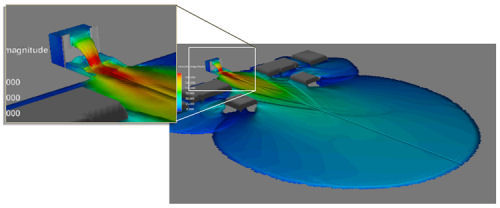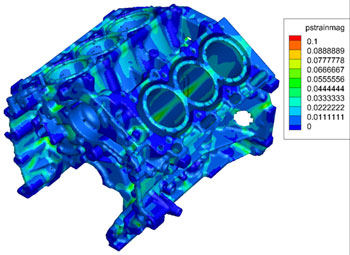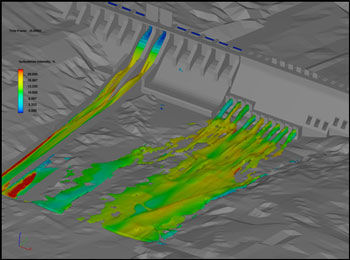CFD Software Scales for Multi-Core Clusters
FLOW-3D/MP sees the debut of an improved automatic decomposition tool intended to save preparation time and effort.
Latest News
May 22, 2013
 Flooding of a large area with flow originating at a weir. The weir is modeled in a 3D mesh block linked to a shallow water block that contains the flood area downstream. Image courtesy of Flow Science, Inc. |
A hybrid parallel version of FLOW-3D v10.1, FLOW-3D/MP enables users with access to Linux HPC clusters to obtain simulation results for their transient free-surface problems. FLOW-3D/MP v5.0, says the company, offers users substantial performance improvements over FLOW-3D v10.1 with possible scaling up to 128 cores or more. The software uses a multi-block domain decomposition technique to distribute the simulation onto compute nodes in a cluster. Parallelization is based on the Hybrid MPI-OpenMP methodology, and the software features true domain decomposition to reduce the computational resources required to model complex flows.
FLOW-3D/MP 5.0 is fully compatible with the FLOW-3D v10.1 GUI for post-processing results, and its physical models and numerical methods are based on FLOW-3D v10.1. Additionally, the physical models of version 5.0 are fully synced with FLOW-3D v10.1.
 This image shows the plastic strain magnitude of a cast aluminum V6 engine block after cooling 20 minutes. Image courtesy of Flow Science, Inc. |
The ADT tool, which automates the domain decomposition process, saving users time and effort when preparing a distributed simulation with FLOW-3D/MP, has been improved in version 5.0. It also enables repeatability of performance. With ADT, users generate an initial mesh as they would normally, taking into account accuracy, physics, and memory usage. Users then launch ADT to obtain a new mesh intended for running with FLOW-3D/MP.
ADT, says the company, is an adaptation of the preprocessor. Consequently, it can use the actual active-cell count to decompose the mesh. The company explains that ADT takes into account the number of active cells in the domain and uses a recursive bisection algorithm to divide the domain into subdomains with approximately equal number of cells in each subdomain. ADT may switch the plane of division depending on the aspect ratio, thus minimizing communication. ADT can handle a multi-block initial mesh as input, which allows the use of multiple blocks to vary the mesh resolution in the domain and the selection of region of interest.
 This image shows turbulence intensity. Image courtesy of Flow Science, Inc. |
The previous version of FLOW-3D/MP was an Intel Cluster Ready registered application, and, the company reports, version 5.0 is currently being recertified as required with any new release. As well, FLOW-3D/MP is being validated for Intel s Xeon processor E5-2600 product family hardware, according to the company.
FLOW-3D/MP runs on both workstations and clusters equipped with Redhat Enterprise Linux (5 or 6) or SUSE Linux 11, a network interconnect such as Gigabit Ethernet or InfiniBand, and a large shared NFS disk accessible from all nodes in the cluster. FLOW-3D/MP supports Intel MPI, which is provided as a part of the installation. Additionally, in collaboration with Silicon Mechanics a turnkey cluster solution for FLOW-3D/MP is available.
“Parallelization is the future of CFD, said Michael Barkhudarov, vice president of research and development at Flow Science in a press statement. Users continue to simulate larger and more complex problems. By heavily investing in the development of our HPC infrastructure, we will allow our users to meet and even exceed their complex simulation needs.”
For more information on FLOW-3D/MP version 5.0, visit Flow Science.
Go to the benchmarks page for a performance analysis of FLOW-3D/MP.
Download the FLOW-3D/MP features list.
Learn more about the Automatic Decomposition Tool in FLOW-3D/MP.
Go here for more on the FLOW-3D/MP parallelization approach.
Click for a discussion of true domain decomposition.
Register to watch a demo of FLOW-3D.
Register to access an assortment of on-demand FLOW-3D webinars.
Learn more about the turnkey cluster for running FLOW-3D/MP.
See why DE’s editors selected FLOW-3D/MP version 5.0 as their Pick of the Week.
Sources: Press materials received from the company and additional information gleaned from the company’s website.
Subscribe to our FREE magazine, FREE email newsletters or both!
Latest News
About the Author
Anthony J. Lockwood is Digital Engineering’s founding editor. He is now retired. Contact him via [email protected].
Follow DE





